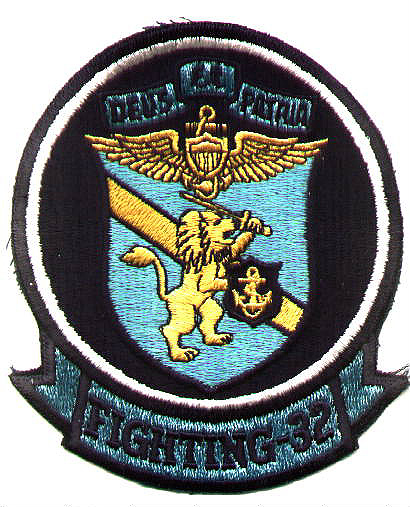

VF-32 Insignia Courtesy of Darryl Shaw |
The VF-32 lineage can be traced back to it's establishment as VBF-3
on 1st of February 1945, 3 years later on 7th August 1948 the squadron
gained it's present designation. VF-32 deployed to the Korean theatre
of war in 1950 with F4U-4 Corsairs. December the 4th, 1950 saw an
impressive show of courage earn a VF-32 pilot the Congressional Medal
of Honor. While on a strike against the Chosin reservoir the F4U-4
Corsair of ENS J.L.Brown was shot down. To try and save his
squadron mate from capture LTJG Hudner landed his plane alongside
ENS Brown. Although his brave attempt ended in failure Hudner's
bravery was recognised by the award of the medal, while ENS Brown
received the D.F.C.
After Korea VF-32 moved from Corsairs to the F9F-6 Cougar, then in
1956 became the first US Navy squadron to receive the F8U-1 Crusader,
in the process becoming the first supersonic squadron in the Navy.
Nine years with the Crusader followed, till in 1965 VF-32 moved to the
F-4B Phantom II. Finally in July 1974 VF-32 began to transition to the
F-14A , the first East Coast squadron to make the change. Their first
deployment with their new mount began in June 1975. During this
cruise the squadron received the Adm. Joseph Clifton Award, signifying
them as the best squadron in the Navy, an impressive achievement after
only so short a time with their new equipment.
1979 saw VF-32 setting another record, the 19th of October saw the
squadron complete 10 years of accident free flying and 17,000 accident
free hours in the F-14.
On these and almost all subsequent deployments VF-32 was partnered
by VF-14. While the partner squadron was fairly consistent the air wing
assignment changed several times:- on it's first cruise (and two
subsequent) ones VF-32 was part of CVW-1 onboard USS John
F.Kennedy (CV-67). In 1982 they moved to USS Independence (CV-62)
for a cruise, after which the squadron started to receive the TARPS
pod and suitably wired F-14's. This capability was extremely useful in
the next cruise, again onboard USS Independence (CV-62), when it was
used to provide high quality photo intelligence to support US forces in
both Grenada and Lebanon. For this second cruise onboard USS
Independence both VF-32 and VF-14 were moved to be part of CVW-6.
A third Independence cruise was made between October 1984 and
February 1985.
 |
| VF-32 markings from the mid to late 1980s |
 |
In the early 80's, with the introduction of all over gull grey
camoflage the middle yellow band was removed, the tailcode reduced in
size and the sword moved onto the stabilator, the tailcode being
superimposed upon it.
When VF-32 moved carriers and air wings the markings changed
significantly. The tailcode, now 'AE' was placed vertically down the
rudder, while the sword was replaced by a twin tailed tomcat (of the
feline variety) leaning upon a sword. As TPS greys were intorduced
the yellow was removed from the remaining tail bands, replaced by a
contrasting grey.
By the 1991 Gulf War VF-32 had reverted to their earlier style of
markings, although by now all the tail markings were in grey rather
than black. However, as with all Navy squadrons, VF-32 was allowed to
paint up to two aircraft in hi-vis markings. These aircraft featured
black tails, with a large yellow sword, the tailcode 'AC' in black but
shadowed in yellow and the upper and lower tail bands in yellow. At
times the legend 'SWORDSMEN' was carried on the rudder. The aircraft
also featured a black hood running from the nose, around the cockpit
onto the spine.
In the latest pictures I have (early 1996) VF-32's markings feature
three black lines in place of each of the upper and lower bands. These
lines are also now carried on the inside of the tail. The sword is
outlined in black, filled in with white. Black shadowing is used to
reprsent the 'AC' tailcode and all aircraft now feature the 'SWORDSMEN'
legend on the rudder. The hi-vis aircraft have lost their black tails,
instead featuring yellow where most of the aircraft use white, but have
retained the canopy hood.
[Main Page] [F-14A] [F-14B] [F-14D] [Tomcat 21] [Atlantic Fleet Squadron Histories] [Pacific Fleet Squadron Histories] [F-14A Images] [F-14B Images] [F-14D Images] [F-14 Model Kits] [US Navy Air Wings] [A-6 images]